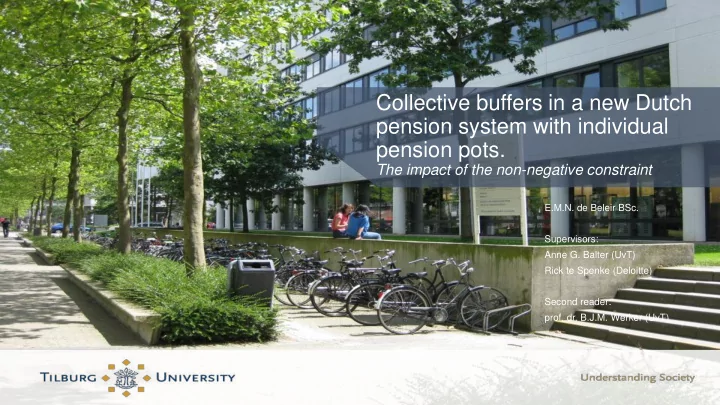

Collective buffers in a new Dutch pension system with individual pension pots. The impact of the non-negative constraint E.M.N. de Beleir BSc. Supervisors: Anne G. Balter (UvT) Rick te Spenke (Deloitte) Second reader: prof. dr. B.J.M. Werker (UvT)
Dutch pension system • 3 pension pillars • First: AOW • Second: Occupational pension plan • Defined benefit (DB) • Defined contribution (DC) • “Doorsneesystematiek” • Third: private savings
Pension reform • Abolisch “Doorsneesystematiek” • Government • Personal pension pots with positive buffer (based on IV-C-R) • FNV • If personal pension pots positive/negative buffers • Since more Intergenerational Risk Sharing (IGR)
Intergenerational Risk Sharing (IGR) • Risk wich can be shared between living generations • Micro longevity risk • Disability risk • Risk wich can be shared with future generations • Macro longevity risk • Stock market risk • Inflation risk • Interest rate risk • Discontinuity risk • The risk that future generations are not willing to participate in a (pension) system.
Personal pension wealth with collective risk sharing (IV-C-R) Buffer PPV Pension Premium Benefits
Personal pension wealth with collective risk sharing (IV-C-R) Buffer PPV Pension Premium Benefits
Model assumptions Pay premium between 25 𝑢ℎ and 65 𝑢ℎ year • Receive pension benefit between 65^𝑢ℎ and 85 𝑢ℎ year • • Only stock market risk (no inflation, interest-rate, longevity etc.) • Black and Sholes financial market (normal distributed returns)
Results 1. System with only positive buffers 2. System with both positive and negative buffers 3. System without a buffer Certain equivalent (CE)
Results
Results Certain equivalent (CE)
Results Certain equivalent (CE)
Results Certain equivalent (CE)
Results
Results Certain equivalent (CE)
Model adjustment: risk premium
Model adjustment: risk premium
Model adjustment: risk premium
Model adjustment: risk premium
Model adjustment: risk premium
Discontinuity risk
Conclusions • A buffer can be beneficial for everyone if • Negative buffers are allowed • A risk premium is provided • Future premiums are constant • Trade-off between discontinuity risk and welfare gains.
Recommend
More recommend